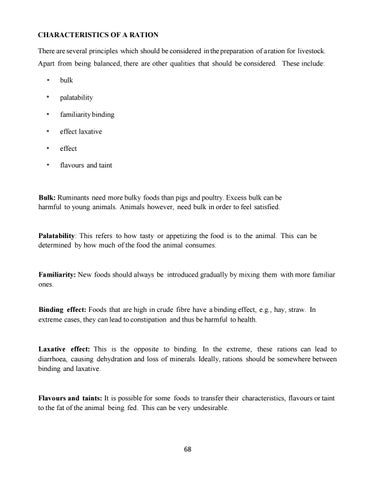CHARACTERISTICS OF A RATION There are several principles which should be considered in the preparation of a ration for livestock. Apart from being balanced, there are other qualities that should be considered. These include:
•
bulk
•
palatability
•
familiarity binding
•
effect laxative
•
effect
•
flavours and taint
Bulk: Ruminants need more bulky foods than pigs and poultry. Excess bulk can be harmful to young animals. Animals however, need bulk in order to feel satisfied.
Palatability: This refers to how tasty or appetizing the food is to the animal. This can be determined by how much of the food the animal consumes.
Familiarity: New foods should always be introduced gradually by mixing them with more familiar ones.
Binding effect: Foods that are high in crude fibre have a binding effect, e.g., hay, straw. In extreme cases, they can lead to constipation and thus be harmful to health.
Laxative effect: This is the opposite to binding. In the extreme, these rations can lead to diarrhoea, causing dehydration and loss of minerals. Ideally, rations should be somewhere between binding and laxative.
Flavours and taints: It is possible for some foods to transfer their characteristics, flavours or taint to the fat of the animal being fed. This can be very undesirable.
68
